NOW & NEW
- Experience
Miyoshi Kinsai Festival: Party in the Northeast Countryside
Summer is indeed festival season all over Japan, and it’s during this time of year that I proactively look up dates for summer festivals in Hiroshima Prefecture, as well as a period in which my smartphone buzzes endlessly with notifications regarding upcoming events near me. However, news of significant summer events tends to be dominated by those happening in Hiroshima City and other parts of the Aki area (mostly Miyajima and Saijo). There are occasionally other tidbits of info on festivals in coastal cities like Takehara, Onomichi, and Fukuyama that cross my field of vision, but what of the celebrations happening up north? It was out of this curiosity that I became determined to investigate events in Hiroshima’s hinterland, and on the 30th of June, I made an effort to partake in a nocturnal cormorant fishing tour up in Miyoshi, which was unfortunately thwarted by rain.
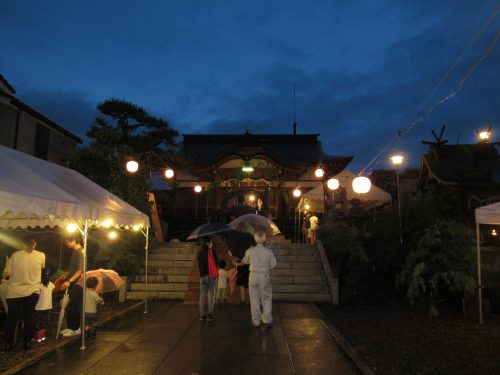
That day just so happened to be the Nagoshi no Oharae Festival, and the rain conveniently stopped before the festivities began. All in all, it was a relatively small affair in which people take an arrow-shaped talisman and walk through a straw hoop, praying that the coming summer will be safe. There was only one street with food stands and this particular event paled in comparison with the Sumiyoshi Festival in Hiroshima City (where a similar method of prayer is practiced), so at first, this trip didn’t warrant an article. I nabbed a crepe with whipped cream and sprinkles before heading back, and soon after began prepping myself for an even bigger festival that would occur at the end of July: the Miyoshi Kinsai Festival.
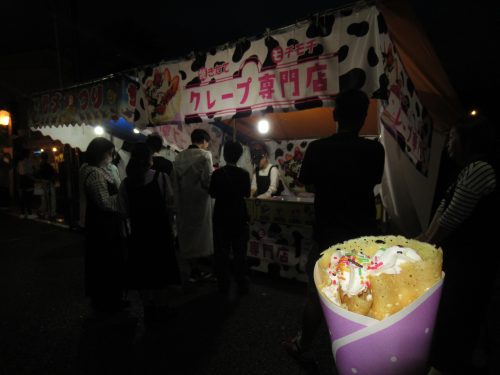
Pre-Fest
Aside from the usual research that would precede a one-day bus trip to this festival in Miyoshi, one crucial thing that must be done before the start of the festival is to apply sunscreen! I did so right after alighting the bus because the weather was indeed blistering and I knew I would be too preoccupied to slop on sunblock during the festivities. It might even be a good idea to reapply sunscreen depending on the amount of time spent outdoors and not in the shade, but do make sure to wear a hat for added protection from those intense UV rays. With that knocked off the list, I began scouting the food stands along the streets, some still preparing, and others already eager to sell their snacks to passersby.
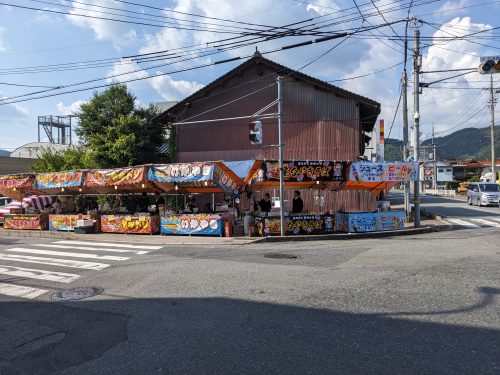
As I was walking down the street, my eyes were met by a stand featuring the Filipino flag, which was in a section seemingly reserved for international organizations selling the foods of their respective countries. There was Filipino shaved ice, Thai curry, Brazilian churrasco, and much more that wouldn’t be sold at any other stand that day. I made a note of the place and continued down the street toward the main festival site, which was on the other side of the river.
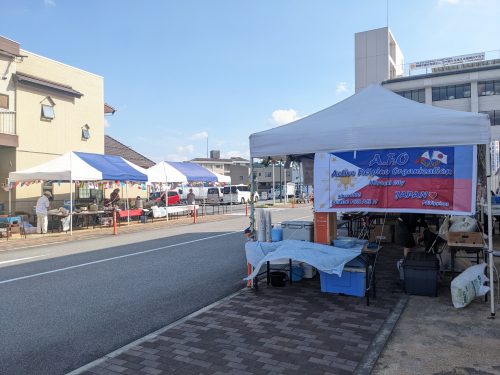
I soon came upon a red, arched bridge, and while crossing over it, was treated to this dazzling vista. The shimmering sunlight was undoubtedly a welcome change of pace from the torrential rain that ruined my trip in late June and the showers that popped up time and again in recent days. If not for the Kinsai Festival, it might have been an impeccable evening to join the cormorant fishing tour, but alas, the parade was calling.
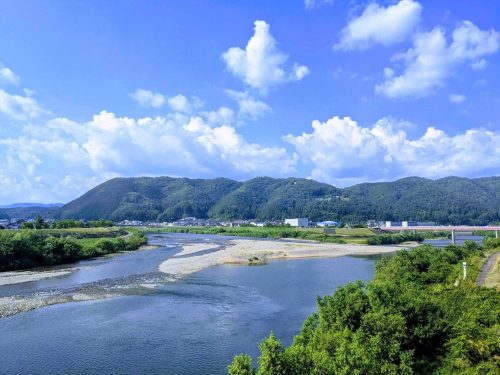
On the other side of the bridge was Miyoshi’s Sumiyoshi Shrine, which was looking spiffy, but wasn’t the focus of the day. I took the path to the left of the shrine, which took me past some quaint, old-timey houses. The streets were all unbelievably hot, so a water truck drove down that path on the left, drizzling cool water on the path to help keep the festival goers from burning while walking.

Kicking Things Off
After a while, I reached the parking lot of local supermarket “yotte-ne,” where the Miyoshi Kinsai Festival would officially commence. Gathered at this site were the Miyoshi Tourism Ambassadors, three ladies in yellow whose job was to promote Miyoshi as a tourist destination and kick off the day’s festivities. With a few words from said ambassadors, the festival was officially underway, and visitors got straight to buying food and having fun.
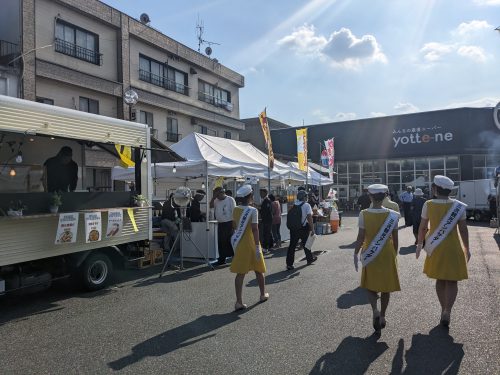
The first performance of the day was a taiko troupe of elementary-schoolers, whose drums were set up in the middle of an intersection blocked off to vehicle traffic on account of the parade. It seemed a lot of local families came to see these kids play, as many children in the crowd presumably knew some of the performers and were calling them by name. I secured an advantageous spot in the street to capture some video footage of the troupe playing, all the while enduring the scorching rays that wanted to pierce the sunblock I had applied earlier.

In this one parking lot alone there was a lot to do, see, and eat. Aside from the stands and food trucks selling yummy delights, there was a space for kids to try their hand at shooting hoops, scoop plastic bouncy balls out of water with a net, and even try out a skateboard or BMX bike on some impromptu, wooden skate park equipment. I was a bit too hot and thirsty for any kind of sport that day, so I instead hit up a refreshment stand and ordered myself a chilled smoothie made with pione grapes, a cultivar traditionally grown in this corner of Hiroshima Prefecture.
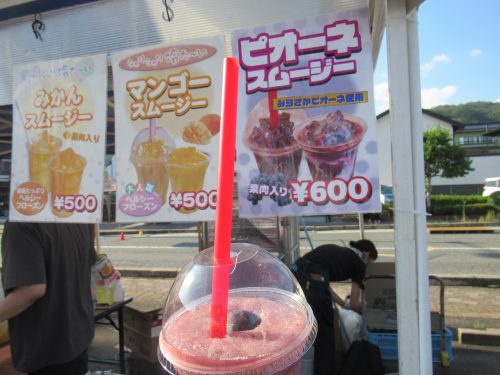
I took my smoothie and proceeded down the street to where the parade was waiting to begin. As I was early, the initial float was on standby, and people inside were throwing snacks to the children gathered around it. The parade would begin in only a few minutes, but in this heat, it felt like forever, and I ended up gulping down the rest of my smoothie in that short while. After all the snacks ran out, they started interviewing some of the kids participating in the parade and commenting on all of the day’s events up until the time to start finally came. The procession featured flag twirlers, musicians, dancers, mascot characters, and miscellaneous folks marching with banners in hand.
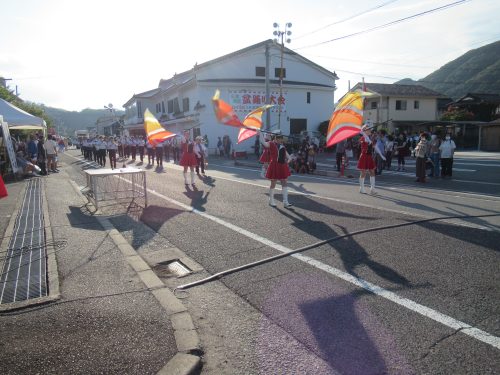
The March Back
After the above flag twirlers passed me by, I pursued the head of the parade back to the parking lot of “yotte-ne” so that I could watch while eating snacks. I had been watching some men grilling chicken “korokoroyaki” before the start of the parade, and having never seen it before, was itching to buy a box to try. After smelling the chicken-flavored smoke and hearing the MCs talk about how tasty it was, I caved and bought me some korokoroyaki to eat while watching the parade pass me by.
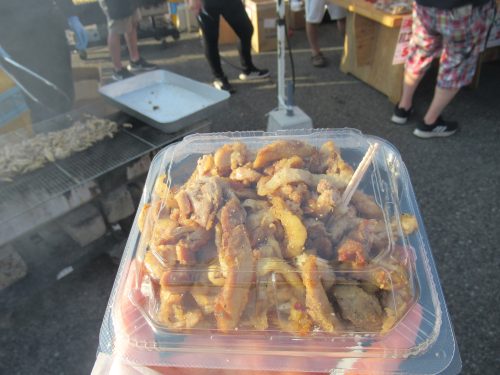
There was music of every genre I could imagine playing at various points throughout the parade depending on the type of dance in each segment. There was one specific, catchy tune that popped up again and again though, played with traditional musical instruments in happi. I figured it was the Miyoshi Kinsai Festival equivalent of “Hanaguruma,” which Hiroshima City constantly uses in its Flower Festival.
My korokoroyaki were taking longer to eat than anticipated, but I wanted to see where the parade was headed and had no time to sit and finish the entire box, so I eventually stood up and followed the parade once again. There were others who had the same idea as I so foot traffic didn’t flow so smoothly, but the march through the streets I came from wasn’t as cramped as I thought it was going to be. If anything, squeezing through the streets with the performers was basically a moving front row seat to the entertainment, and watching these cheerful faces in flashy costumes liven everything around them was a lot of fun for me. That fun factor was multiplied when I started seeing the occasional participant dressed up as characters I recognize, such as the pink-haired Mitsuri Kanroji from Demon Slayer.
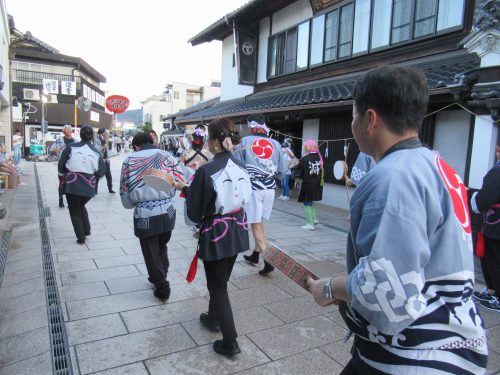
It wasn’t just grown-ups partying through the streets of town, either; a good number of dance troupes were made up solely of local school kids in matching T-shirts. These juvenile convoys were led, backed, and flanked by guardians and older kids with water guns spraying them every few seconds to keep them cool while they busted their best moves. I took a page from their book and got myself a chilled bottle of ramune from a nearby stand to drink as I marched alongside them. Even as the sun was setting, the water spraying and drink vendors everywhere were a necessity on account of the intense heat.
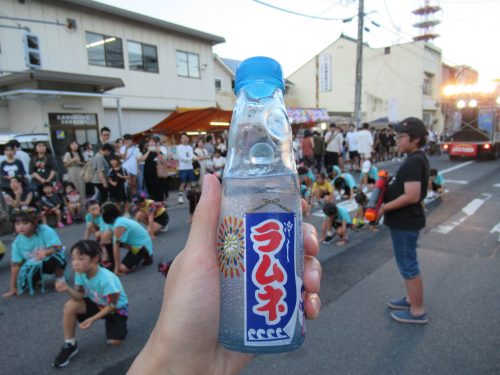
Moment of Joy: Be A Hero
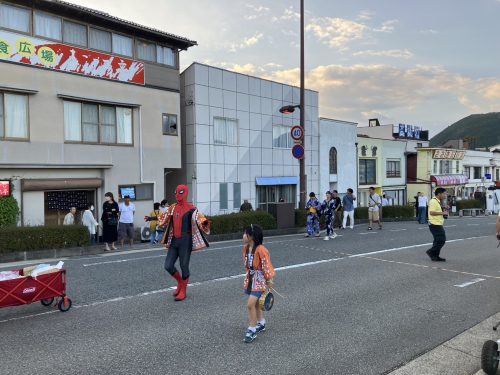
Of all the outfits donned that day, the one that takes the cake and eats it too would have to be Spider-Man in an orange happi. This one man (or at least I think he was a man) attracted the attention of onlookers inside and outside the procession, and was especially a hit with the kids. The Miyoshi Kinsai Festival may still retain a lot of tradition, but cosplayers like this one prove that regardless of a festival’s age, there is always room for innovative twists. This Spider-Man may have just been one participant in the parade and thus not the focus of the event, but to many of us simply passing by, expecting your typical traditional festival getups, we saw a childhood hero save the day from monotony and contribute to Miyoshi’s festive atmosphere.
Celebrating Into the Night
I eventually ended up back where the international food stands were, but I walked past those stands to the stage area, which had tables where spectators could stand and eat while watching live entertainment. This was the perfect place for me to finish my korokoroyaki, but more importantly, I was here to see a performance that foreshadowed my next adventure over Obon: a demonstration of the dance performed at Mihara’s Yassa Festival. A throng of Mihara locals made the journey up to Miyoshi to party it up on stage, and everyone in the crowd was invited to jump in to dance with them. Had I finished my food earlier and had more energy in me, I might have humored the thought of joining them myself, but that afternoon, it was enough for me to simply watch while indulging in my grilled chicken.
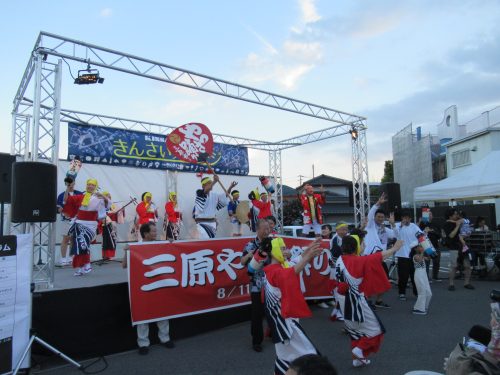
After that performance concluded, the Mihara locals on stage were interviewed, at which point they cordially invited us to the Yassa festival that would be held in mid-August. Following the interview, other troupes took the stage, including a breakdancing group, a gospel group, and musicians of other genres. When I finished my food, I decided to stroll about and check out the other food stalls for something else to chow down on.
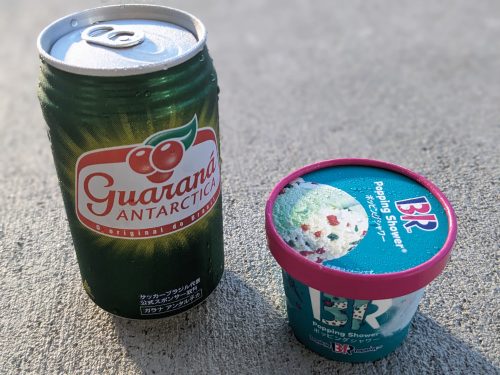
As stated previously, there were a lot of international foods on tap, but besides the hot foods being freshly prepared, I was ecstatic to find out that some of my favorite overseas brands of snacks and soft drinks were represented in little old Miyoshi. I was indecisive on an actual meal, though there were some pretty strong contenders, such as authentic Italian pizza, grilled chicken and vegetables, and green curry, but after some intense debating, I went with some ice cream and soda, then opted to catch a bus back to Hiroshima City for dinner. The food stalls actually got even more crowded later into the night, which meant it would take a while for me to get actual food, causing me to miss my bus. Sad as it was, I decided to call it a night at this point.
The name of the Miyoshi Kinsai Festival originates from a saying in the Hiroshima dialect of Japanese: “kinsai (来んさい)” roughly translates to “come on over,” a frank but warm invitation for all to visit Miyoshi. For a small city, Miyoshi punches above its weight in terms of seasonal festivals, and considering how often they happen, tourists could definitely justify a trip up north to join in on even one. While I do enjoy the summer festivals that happen in Hiroshima City and its coastal neighbors, summer break affords a lot of time to attend events in any part of the prefecture, so there really is no reason for me to turn down chances to go farther inland. I have absolutely no doubt in my mind that Miyoshi will tell us all to “kinsai” next year as well, and when that happens, I hope you too will expand your Hiroshimarian horizons and answer that call to come on over!
Written by the Joy in Hiroshima Team
